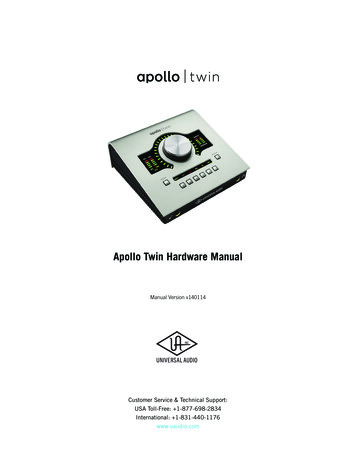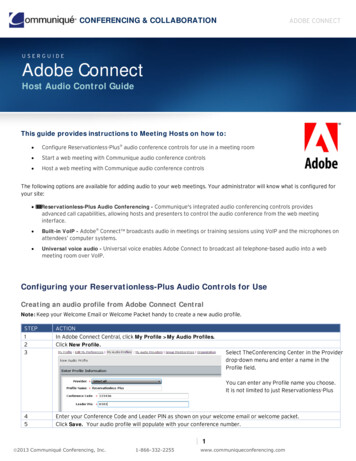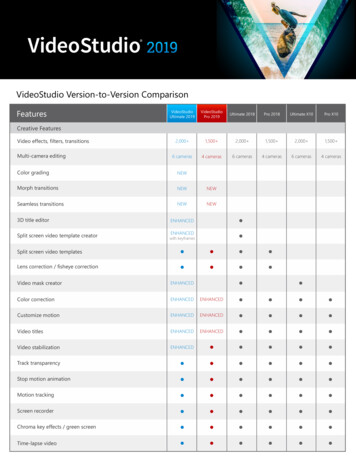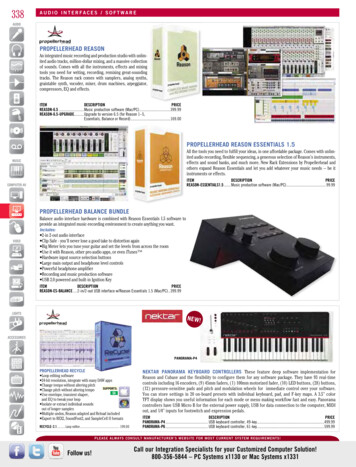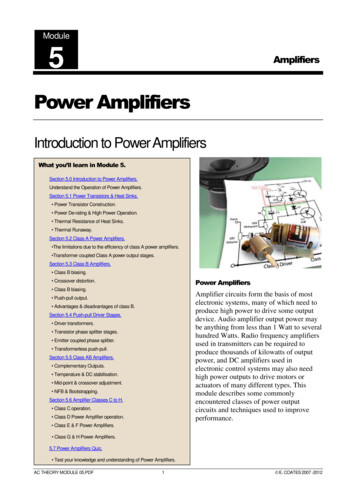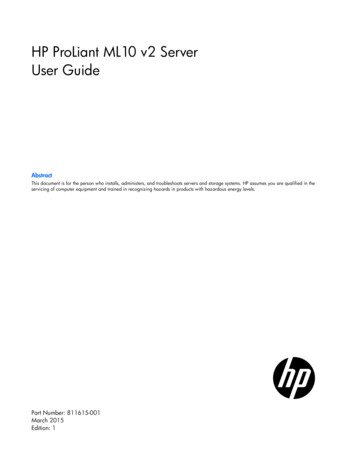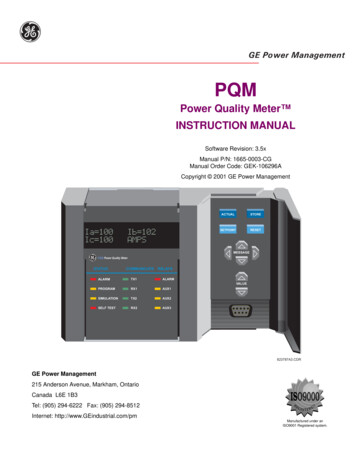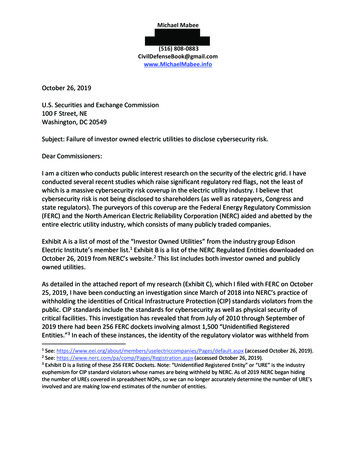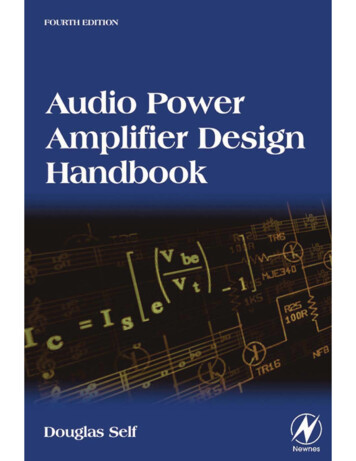
Transcription
Audio PowerAmplifierDesign Handbook
Audio PowerAmplifierDesign HandbookFourth editionDouglas Self MA, MScAMSTERDAM BOSTON HEIDELBERG LONDON NEW YORK OXFORDPARIS SAN DIEGO SAN FRANCISCO SINGAPORE SYDNEY TOKYONewnes is an imprint of Elsevier
Newnes is an imprint of ElsevierLinacre House, Jordan Hill, Oxford OX2 8DP30 Corporate Drive, Burlington, MA 01803First published 2006Copyright 2006, Douglas Self. All rights reservedThe right of Douglas Self to be identified as the author of this work has beenasserted in accordance with the Copyright, Designs and Patents Act 1988No part of this publication may be reproduced in any material form (includingphotocopying or storing in any medium by electronic means and whether or nottransiently or incidentally to some other use of this publication) without the writtenpermission of the copyright holder except in accordance with the provisions of theCopyright, Designs and Patents Act 1988 or under the terms of a licence issuedby the Copyright Licensing Agency Ltd, 90 Tottenham Court Road, London,England W1T 4LP. Applications for the copyright holder’s written permission toreproduce any part of this publication should be addressed to the publisherPermissions may be sought directly from Elsevier’s Science and Technology RightsDepartment in Oxford, UK: phone: ( 44) (0) 1865 843830; fax: ( 44) (0) 1865853333; e-mail: permissions@elsevier.co.uk. You may also complete your requeston-line via the Elsevier homepage (http://www.elsevier.com), by selecting‘Customer Support’ and then ‘Obtaining Permissions’British Library Cataloguing in Publication DataSelf, DouglasAudio power amplifier design handbook. — 4th ed.1. Audio amplifiers — Design2. Power amplifiers — DesignI. Title621.3 81535Library of Congress Control Number:2006927666ISBN-13: 978-0-7506-8072-1ISBN-10: 0-7506-8072-5For information on all Newnes publicationsvisit our web site at www.newnespress.comPrinted and bound in Great Britain06 07 08 09 1010 9 8 7 6 5 4 3 2 1Working together to growlibraries in developing countrieswww.elsevier.com www.bookaid.org www.sabre.org
ContentsSynopsisviiPreface to Fourth EditionxviiPrefacexviii1. Introduction and general survey12. History, architecture and negative feedback313. The general principles of power amplifiers624. The small signal stages755. The output stage I1096. The output stage II1667. Compensation, slew-rate, and stability1868. Power supplies and PSRR2399. Class-A power amplifiers25910. Class-G power amplifiers29411. Class-D amplifiers31912. FET output stages32813. Thermal compensation and thermal dynamics33914. The design of DC servos38515. Amplifier and loudspeaker protection39716. Grounding and practical matters43217. Testing and safety454Index464v
SynopsisChapter 1Introduction and general surveyThe economic importance of power amplifiersAssumptionsOrigins and aimsThe study of amplifier designMisinformation in audioScience and subjectivismThe Subjectivist positionA short history of subjectivismThe limits of hearingArticles of faith: the tenets of subjectivismThe length of the audio chainThe implicationsThe reasons whyThe outlookTechnical errorsThe performance requirements for amplifiersSafetyReliabilityPower outputFrequency responseNoiseDistortionDamping factorAbsolute phaseAcronymsChapter 2History, architecture and negativefeedbackA brief history of amplifiersAmplifier architecturesvii
SynopsisThe three-stage architectureThe two-stage amplifier architecturePower amplifier Class-FClass-GClass-HClass-SVariations on Class-BError-correcting amplifiersNon-switching amplifiersCurrent-drive amplifiersThe Blomley principleGeometric mean Class-ABNested differentiating feedback loopsAC- and DC-coupled amplifiersThe advantages of AC-couplingThe advantages of DC-couplingNegative feedback in power amplifiersSome common misconceptions about negative feedbackAmplifier stability and NFBMaximising the NFBMaximising linearity before feedbackChapter 3The general principles of poweramplifiersHow a generic amplifier worksThe advantages of conventionThe eight distortionsDistortion one: input stage distortionDistortion two: VAS distortionDistortion three: output stage distortionDistortion four: VAS loading distortionDistortion five: rail decoupling distortionDistortion six: induction distortionDistortion seven: NFB takeoff distortionDistortion eight: capacitor distortionNon-existent distortionsThe performance of a standard amplifierOpen-loop linearity and how to determine itviii
SynopsisDirect open-loop gain measurementUsing model amplifiersThe concept of the blameless amplifierChapter 4The small signal stagesThe role of the input stageDistortion from the input stageBJTs vs FETs for the input stageAdvantages of the FET input stageDisadvantages of FET input stageSingleton input stage versus differential pairThe input stage distortion in isolationInput stage balanceThe joy of current-mirrorsImproving input-stage linearityRadical methods of improving input linearityInput stage cascode configurationsInput noise and how to reduce itOffset and match: the DC precision issueThe input stage and the slew-rateThe voltage-amplifier stageMeasuring VAS distortion in isolationVAS operationVAS distortionLinearising the VAS: active load techniquesVAS enhancementsThe importance of voltage driveThe balanced VASThe VAS and manipulating open-loop bandwidthManipulating open-loop bandwidthConclusionsChapter 5The output stage IClasses and devicesThe distortions of the outputHarmonic generation by crossover distortionComparing output stagesThe emitter-follower outputThe CFP outputQuasi-complementary outputsTriple-based output configurationsTriple EF output stagesDistortion and its mechanismsix
SynopsisLarge-signal distortion (Distortion 3a)The load-invariant conceptThe LSN mechanismDoubled output devicesBetter output devicesFeedforward diodesTrouble with triplesLoads below 4 Better 8 performanceA practical load-invariant designThe latest findingsSummaryCrossover distortion (Distortion 3b)Output stage quiescent conditionsAn experiment on crossover distortionVq as the critical quiescent parameterSwitching distortion (Distortion 3c)Thermal distortionThermal distortion in a power amp ICSelecting an output stageClosing the loop: distortion in complete amplifiersConclusionsChapter 6The output stage IIDistortion number 4: VAS loading distortionDistortion number 5: rail decoupling distortionDistortion number 6: induction distortionDistortion number 7: NFB takeoff point distortionDistortion number 8: capacitor distortionDesign example: a 50 W Class-B amplifierChapter 7Compensation, slew-rate,and stabilityFrequency compensation in generalDominant-pole compensationLag compensationIncluding the output stage: inclusive Miller compensationNested feedback loopsTwo-pole compensationOutput networksAmplifier output impedanceMinimising amplifier output impedanceZobel networksx
SynopsisOutput inductorsThe output inductor valueCable effectsCrosstalk in amplifier output inductorsConclusionsReactive loads and speaker simulationResistive loadsModelling real loudspeaker loadingLoudspeaker loads and output stagesSingle-speaker loadTwo-way speaker loadsEnhanced loudspeaker currentsAmplifier instabilityHF instabilityLF instabilitySpeed and slew-rate in audio amplifiersThe basics of amplifier slew-limitingSlew-rate measurement techniquesImproving the slew-rateSimulating slew-limitingSlewing limitations in real lifeSome additional complicationsFurther improvements and other configurationsChapter 8Power supplies and PSRRPower supply technologiesSimple unregulated power suppliesLinear regulated power suppliesSwitch-mode power suppliesDesign considerations for power suppliesMains transformersFusing and rectificationRF emissions from bridge rectifiersPower supply-rail rejection in amplifiersA design philosophy for rail rejectionPositive supply-rail rejectionNegative supply-rail rejectionChapter 9Class-A power amplifiersAn introduction to class-AClass-A configurations and efficiencyOutput stages in Class-AQuiescent current control systemsA novel quiescent current controllerxi
SynopsisA Class-A designThe trimodal amplifierLoad impedance and operating modeEfficiencyOn Trimodal biasingClass-A/AB modeClass-B modeThe mode-switching systemThermal designA complete Trimodal amplifier circuitThe power supplyThe performanceFurther possibilitiesChapter 10 Class-G power amplifiersThe principles of Class-GIntroducing series class-GEfficiency of Class-GPracticalitiesThe biasing requirementsThe linearity issues of series Class-GThe static linearityPractical Class-G designControlling small-signal distortionThe performanceDeriving a new kind of amplifier: Class-A CAdding two-pole compensationFurther variations on Class-GChapter 11 Class-D amplifiersHistoryBasic principlesTechnologyProtectionOutput filtersEfficiencyChapter 12 FET output stagesThe characteristics of power FETSFET versus BJT output stagesAdvantages of FETsDisadvantages of FETsxii
SynopsisIGBTsPower FET output stagesPower FETs and bipolars: the linearity comparisonFETs in Class-A stagesChapter 13 Thermal compensationand thermal dynamicsWhy quiescent conditions are criticalAccuracy required of thermal compensationBasic thermal compensationAssessing the bias errorsThermal simulationModelling the EF output stageModelling the CFP output stageThe integrated absolute error criterionImproved thermal compensation: the emitter-follower stageImproved compensation for the CFP output stageA better sensor positionA junction-temperature estimatorA junction estimator with dynamicsConclusionVariable-tempco bias generatorsCreating a higher tempcoAmbient temperature changesCreating a lower tempcoCurrent compensationThermal dynamics in realityResultsEarly effect in output stagesChapter 14 The design of DC servosDC offset trimmingDC offset control by servo-loopThe advantages of DC servosBasic servo configurationsNoise, component values, and the roll-offNon-inverting integratorsChoice of op-ampsServo authorityDesign of LF roll-off pointPerformance issuesMultipole servosxiii
SynopsisChapter 15 Amplifier and loudspeakerprotectionCategories of amplifier protectionSemiconductor failure modesOverload protectionOverload protection by fusesElectronic overload protectionPlotting the protection locusSimple current-limitingSingle-slope VI limitingDual-slope VI limitingSimulating overload protection systemsCatching diodesDC-offset protectionDC protection by fusesRelay protection and muting controlFiltering for DC ProtectionBidirectional DC DetectionDistortion in output relaysOutput crowbar DC protectionProtection by power-supply shutdownThermal protectionPowering auxiliary circuitryChapter 16 Grounding and practical mattersAudio amplifier PCB designCrosstalkRail induction distortionThe mounting of output devicesSingle and double-sided PCBsPower supply PCB layoutPower amplifier PCB layout detailsThe audio PCB layout sequenceMiscellaneous pointsAmplifier groundingGround loops: how they work and how to deal with themHum injection by mains grounding currentsHum injection by transformer stray magnetic fieldsHum injection by transformer stray capacitanceGround currents inside equipmentBalanced mains powerClass I and Class IIWarningxiv
SynopsisMechanical layout and design considerationsCoolingConvection coolingMains transformersWiring layoutSemiconductor installationChapter 17 Testing and safetyTesting and fault-findingSafetySafety regulationsElectrical SafetyEquipment temperature and safetyInstruction manualsxv
I wish to dedicate this book to my parents Russell and Evelyn, and to allthe friends and colleagues who have provided me help, information andencouragement while I was engaged in its writing. In particular I wantto acknowledge the active assistance and collaboration of Gareth Connorin the quest for the perfect amplifier, and the fortitude of Peter King inenduring many rambling expositions of my thoughts on the subject.xvi
Preface to FourthEditionThe Audio Power Amplifier Design Handbook has now reached its Fourthedition, and it is very good to see that it fulfils a real need. It has once againbeen expanded with a significant amount of new material. This time twowhole new chapters have been added, one on the Design of DC Servos forcontrolling output offsets and another on Class-D Amplifiers, which havegrown markedly in importance in recent times.There have also been major new sections added on the detailed designof DC protection circuitry, and on the Safety regulations. No DC-coupledpower amplifier can be regarded as complete until it has proper DCprotection – having an amplifier fail is bad enough, but having it fail andtake an expensive loudspeaker with it is downright upsetting. If you aredesigning an amplifier for commercial production, then a knowledge ofthe various safety requirements is of course vital; such considerations canhave a profound effect on how a piece of equipment is constructed.I would like to thank everyone who has supported me in the productionand evolution of The Handbook, not least those who have done so bybuying it.xvii
PrefaceThe design of power amplifiers exerts a deep fascination all of its own inboth amateur and professional circles. The job they do is essentially simple,but making a reliable high-performance circuit to do it well is surprisinglydifficult, and involves delving into all kinds of byways of electronics. Perhaps this paradox is at the root of the enduring interest they generate.Reliable information on power amplifier design is hard to find, but in thisbook, I hope to fill at least some of that need.It is notable how few aspects of amplifier design have received seriousscientific investigation. Much of this book is the result of my own research,because the information required simply was not to be found in the published literature.In the course of my investigations, I was able to determine that poweramplifier distortion, traditionally a difficult and mysterious thing to grapplewith, was the hydra-headed amalgamation of seven or eight mechanisms,overlaying each other and contributing to a complex result. I have evolvedways of measuring and minimising each distortion mechanism separately,and the result is a design methodology for making Class-B or Class-A amplifiers with distortion performance so good that two or three years ago itwould have been regarded as impossible. The methodology gives pleasingly reliable and repeatable results with moderate amounts of negativefeedback, and insignificant added cost. It is described and explained indetail here.This leads to the concept of what I have called a Blameless amplifier,which forms a benchmark for distortion performance that varies surprisinglylittle, and so forms a well-defined point of departure for more ambitiousand radical amplifier designs. The first of these I have undertaken is theTrimodal amplifier (so-called because it can work in any of the modes A,AB and B, as the situation requires) which is fully described in Chapter 9.Apart from the major issue of distortion and linearity in power amplifierdesign, I also cover more mundane but important matters such as reliability, power supplies, overload and DC-protection, and so on. In additionxviii
Prefacethere is unique material on reactive loading, unusual forms of compensation, distortion produced by capacitors and fuses, and much more. I haveprovided a wide and varied selection of references, so that those interestedcan pursue the issues further.Sometimes controversies arise in audio; in fact, it would be truer to say thatthey have become endemic, despite a lack of hard facts on which genuinedifferences of opinion might be based. Although audio power amplifiersare in many ways straightforward in their doings, they have not escaped theattentions of those who incline more to faith than science. In my writings,I simply go where the facts lead me, and my experiences as an amateurmusician, my work designing professional mixing consoles, and my studiesin psychology and psychoacoustics have led me to the firm conclusion thatinexplicable influences on audio quality simply do not exist, and that anyserious book on amplifier design must start from this premise.I have done my best to make sure that everything in this book is as correctas theory, simulation, practical measurement and late-night worrying canmake it. The basic arguments have been validated by the production ofmore than twenty thousand high-power Blameless amplifiers over the lasttwo years, which is perhaps as solid a confirmation as any methodologycan hope to receive. If some minor errors do remain, these are entirely myresponsibility, and when alerted I will correct them at the first opportunity.I hope this book may be interesting and useful to the amplifier designerand constructor, be they an amateur or a professional. However, it is myfondest wish that it may stimulate others to further explore and expand thelimits of audio knowledge.Douglas Selfxix
1Introduction and generalsurveyThe economic importance of power amplifiersAudio power amplifiers are of considerable economic importance. Theyare built in their hundreds of thousands every year, and have a historyextending back to the 1920s. It is therefore surprising there have been sofew books dealing in any depth with solid-state power amplifier design.The first aim of this text is to fill that need, by providing a detailed guideto the many design decisions that must be taken when a power amplifieris designed.The second aim is disseminate the results of the original work done onamplifier design in the last few years. The unexpected result of these investigations was to show that power amplifiers of extraordinarily low distortioncould be designed as a matter of routine, without any unwelcome sideeffects, so long as a relatively simple design methodology was followed.This methodology will be explained in detail.AssumptionsTo keep its length reasonable, a book such as this must assume a basicknowledge of audio electronics. I do not propose to plough through the definitions of frequency response, THD and signal-to-noise ratio; this can befound anywhere. Commonplace facts have been ruthlessly omitted wheretheir absence makes room for something new or unusual, so this is notthe place to start learning electronics from scratch. Mathematics has beenconfined to a few simple equations determining vital parameters such asopen-loop gain; anything more complex is best left to a circuit simulatoryou trust. Your assumptions, and hence the output, may be wrong, but atleast the calculations in-between will be correct .1
Audio Power Amplifier Design HandbookThe principles of negative feedback as applied to power amplifiers areexplained in detail, as there is still widespread confusion as to exactly howit works.Origins and aimsThe core of this book is based on a series of eight articles originally published in Electronics World as ‘Distortion In Power Amplifiers’. This serieswas primarily concerned with distortion as the most variable feature ofpower amplifier performance. You may have two units placed side byside, one giving 2% THD and the other 0.0005% at full power, and bothclaiming to provide the ultimate audio experience. The ratio between thetwo figures is a staggering 4000:1, and this is clearly a remarkable state ofaffairs. One might be forgiven for concluding that distortion was not a veryimportant parameter. What is even more surprising to those who have notfollowed the evolution of audio over the last two decades is that the moredistortive amplifier will almost certainly be the more expensive. I shall dealin detail with the reasons for this astonishing range of variation.The original series was inspired by the desire to invent a new output stagethat would be as linear as Class-A, without the daunting heat problems.In the course of this work it emerged that output stage distortion wascompletely obscured by non-linearities in the small-signal stages, and itwas clear that these distortions would need to be eliminated before anyprogress could be made. The small-signal stages were therefore studied inisolation, using model amplifiers with low-power and very linear Class-Aoutput stages, until the various overlapping distortion mechanisms hadbeen separated out. It has to be said this was not an easy process. In eachcase there proved to be a simple, and sometimes well-known cure, andperhaps the most novel part of my approach is that all these mechanismsare dealt with, rather than one or two, and the final result is an amplifierwith unusually low distortion, using only modest and safe amounts ofglobal negative feedback.Much of this book concentrates on the distortion performance of amplifiers. One reason is that this varies more than any other parameter – byup to a factor of a thousand. Amplifier distortion was until recently anenigmatic field – it was clear that there were several overlapping distortionmechanisms in the typical amplifier, but it is the work reported here thatshows how to disentangle them, so they may be separately studied andthen with the knowledge thus gained, minimised.I assume here that distortion is a bad thing, and should be minimised; I makeno apology for putting it as plainly as that. Alternative philosophies hold thatas some forms of non-linearity are considered harmless or even euphonic,they should be encouraged, or at any rate not positively discouraged. I state2
Introduction and general surveyplainly that I have no sympathy with the latter view; to my mind the goal isto make the audio path as transparent as possible. If some sort of distortionis considered desirable, then surely the logical way to introduce it is byan outboard processor, working at line level. This is not only more costeffective than generating distortion with directly heated triodes, but has theimportant attribute that it can be switched off. Those who have brought intobeing our current signal-delivery chain, i.e., mixing consoles, multi-trackrecorders, CDs, have done us proud in the matter of low distortion, and towilfully throw away this achievement at the very last stage strikes me ascurious at best.In this book I hope to provide information that is useful to all those interested in power amplifiers. Britain has a long tradition of small and verysmall audio companies, whose technical and production resources may notdiffer very greatly from those available to the committed amateur. I hopethis volume will be of service to both.I have endeavoured to address both the quest for technical perfection –which is certainly not over, as far as I am concerned – and also thecommercial necessity of achieving good specifications at minimum cost.The field of audio is full of statements that appear plausible but in facthave never been tested and often turn out to be quite untrue. For thisreason, I have confined myself as closely as possible to facts that I haveverified myself. This volume may therefore appear somewhat idiosyncraticin places; for example, FET output stages receive much less coverage thanbipolar ones because the conclusion appears to be inescapable that FETsare both more expensive and less linear; I have therefore not pursued theFET route very far. Similarly, most of my practical design experience hasbeen on amplifiers of less than 300 W power output, and so heavy-dutydesigns for large-scale PA work are also under-represented. I think this ispreferable to setting down untested speculation.The study of amplifier designAlthough solid-state amplifiers have been around for some 40 years, itwould be a great mistake to assume that everything possible is knownabout them. In the course of my investigations, I discovered several matterswhich, not appearing in the technical literature, appear to be novel, at leastin their combined application: The need to precisely balance the input pair to prevent second-harmonicgeneration.The demonstration of how a beta-enhancement transistor increasesthe linearity and reduces the collector impedance of the VoltageAmplifier Stage.3
Audio Power Amplifier Design Handbook An explanation of why BJT output stages always distort more into 4 than 8 .In a conventional BJT output stage, quiescent current as such is of little importance. What is crucial is the voltage between the transistoremitters.Power FETs, though for many years touted as superior in linearity, areactually far less linear than bipolar output devices.In most amplifiers, the major source of distortion is not inherent in theamplifying stages, but results from avoidable problems such as inductionof supply-rail currents and poor power-supply rejection.Any number of oscillograms of square-waves with ringing have beenpublished that claim to be the transient response of an amplifier into acapacitive load. In actual fact this ringing is due to the output inductorresonating with the load, and tells you precisely nothing about amplifierstability.The above list is by no means complete.As in any developing field, this book cannot claim to be the last word onthe subject; rather it hopes to be a snapshot of the state of understanding atthis time. Similarly, I certainly do not claim that this book is fully comprehensive; a work that covered every possible aspect of every conceivablepower amplifier would run to thousands of pages. On many occasions Ihave found myself about to write: ‘It would take a whole book to dealproperly with ’ Within a limited compass I have tried to be innovativeas well as comprehensive, but in many cases the best I can do is to give agood selection of references that will enable the interested to pursue matters further. The appearance of a reference means that I consider it worthreading, and not that I think it to be correct in every respect.Sometimes it is said that discrete power amplifier design is rather unenterprising, given the enormous outpouring of ingenuity in the design ofanalogue ICs. Advances in op-amp design would appear to be particularly relevant. I have therefore spent some considerable time studying thismassive body of material and I have had to regretfully conclude that it isactually a very sparse source of inspiration for new audio power amplifiertechniques; there are several reasons for this, and it may spare the time ofothers if I quickly enumerate them here: 4A large part of the existing data refers only to small-signal MOSFETs,such as those used in CMOS op-amps, and is dominated by the ways inwhich they differ from BJTs, for example, in their low transconductance.CMOS devices can have their characteristics customised to a certainextent by manipulating the width/length ratio of the channel.In general, only the earlier material refers to BJT circuitry, and then it isoften mainly concerned with the difficulties of making complementary
Introduction and general survey circuitry when the only PNP transistors available are the slow lateralkind with limited beta and poor frequency response.Many of the CMOS op-amps studied are transconductance amplifiers,i.e., voltage-difference-in, current out. Compensation is usually based onputting a specified load capacitance across the high-impedance output.This does not appear to be a promising approach to making audio poweramplifiers.Much of the op-amp material is concerned with the common-modeperformance of the input stage. This is pretty much irrelevant to poweramplifier design.Many circuit techniques rely heavily on the matching of device characteristics possible in IC fabrication, and there is also an emphasis onminimising chip area to reduce cost.A good many IC techniques are only necessary because it is (or was)difficult to make precise and linear IC resistors. Circuit design is alsoinfluenced by the need to keep compensation capacitors as small aspossible, as they take up a disproportionately large amount of chip areafor their function.The material here is aimed at all audio power amplifiers that are stillprimarily built from discrete components, which can include anything from10 W mid-fi systems to the most rarefied reaches of what is sometimescalled the ‘high end’, though the ‘expensive end’ might be a more accurateterm. There are of course a large number of IC and hybrid amplifiers, butsince their design details are fixed and inaccessible they are not dealt withhere. Their use is (or at any rate should be) simply a matter of followingthe relevant application note. The quality and reliability of IC power ampshas improved noticeably over the last decade, but low distortion and highpower still remain the province of discrete circuitry, and this situationseems likely to persist for the foreseeable future.Power amplifier design has often been treated as something of a blackart, with the implication that the design process is extremely complexand its outcome not very predictable. I hope to show that this need nolonger be the case, and that power amplifiers are now designable – inother words it is possible to predict reasonably accurately the practicalperformance of a purely theoretical design. I have done a considerableamount of research work on amplifier design, much of which appears tohave been done for the first time, and it is now possible for me to putforward a design methodology that allows an amplifier to be designed for aspecific negative-feedback factor at a given frequency, and to a large extentallows the distortion performance to be predicted. I shall show that thismethodology allows amplifiers of extremely low distortion (sub 0.001% at1 kHz) to be designed and built as a matter of routine, using only modestamounts of global negative feedback.5
Audio Power Amplifier Design HandbookMisinformation in audioFew fields of technical endeavour are more plagued with errors, misstatements and confusion than audio. In the last 20 years, the rise ofcontroversial and non-rational audio hypotheses, gathered under the titleSubjectivism has deepened these difficulties. It is commonplace for hi-fireviewers to claim that the
Audio Power Amplifier Design Handbook Fourth edition Douglas Self MA, MSc AMSTERDAM BOSTON HEIDELBERG LONDON NEW YORK OXFORD PARIS SAN DIEGO SAN FRANCISCO



